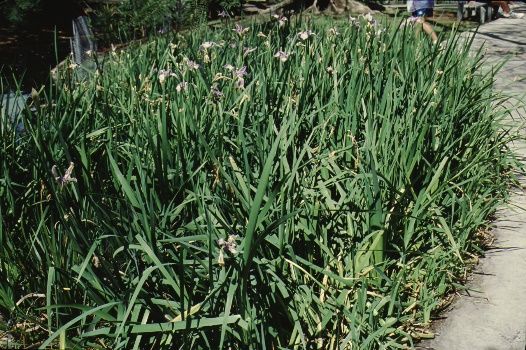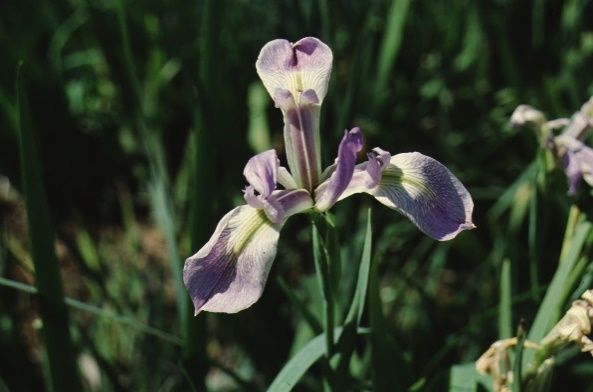Introduction
Blue flag iris has wonderfully textured, light-green foliage emerging directly from the ground in dense clumps. It grows 12 to 18 inches tall, producing lavender-blue flowers about 4 inches across in the spring. Flowers are displayed in a showy fashion slightly above the foliage. They are native to boggy areas where water stands all year long. They will grow in standing water.

Credit: Edward F. Gilman, UF/IFAS

Credit: Edward F. Gilman, UF/IFAS
General Information
Scientific name: Iris virginica
Pronunciation: EYE-riss vur-JIN-nick-uh
Common name(s): Virginia iris, blue flag, blue flag iris
Family: Iridaceae
Plant type: herbaceous; ornamental grass; aquatic plant
USDA hardiness zones: 8B through 11 (Figure 3)
Planting month for zone 8: year-round
Planting month for zone 9: year-round
Planting month for zone 10 and 11: year-round
Origin: native to Florida
Invasive potential: aggressive, spreading plant
Uses: border; mass planting; container or above-ground planter; naturalizing; water garden; accent
Availability: somewhat available, may have to go out of the region to find the plant

Credit:
Description
Height: 4 to 7 feet
Spread: 1 to 3 feet
Plant habit: upright
Plant density: moderate
Growth rate: moderate
Texture: coarse
Foliage
Leaf arrangement: most emerge from the soil, usually without a stem
Leaf type: simple
Leaf margin: entire
Leaf shape: linear
Leaf venation: parallel
Leaf type and persistence: evergreen
Leaf blade length: 18 to 36 inches
Leaf color: green
Fall color: no fall color change
Fall characteristic: not showy
Flower
Flower color: blue
Flower characteristic: spring flowering
Fruit
Fruit shape: elongated
Fruit length: 0.5 to 1 inch
Fruit cover: dry or hard
Fruit color: green
Fruit characteristic: persists on the plant
Trunk and Branches
Trunk/bark/branches: typically, multi-trunked or clumping stems
Current year stem/twig color: not applicable
Current year stem/twig thickness: not applicable
Culture
Light requirement: plant grows in part shade/part sun
Soil tolerances: extended flooding; slightly alkaline; clay; sand; acidic; loam
Drought tolerance: moderate
Soil salt tolerances: poor
Plant spacing: 24 to 36 inches
Other
Roots: not applicable
Winter interest: no special winter interest
Outstanding plant: not particularly outstanding
Pest resistance: long-term health usually not affected by pests
Use and Management
The plant is grown and used for its foliage effect as well as the flower display. The plant flowers for a short period in the spring but the coarse-textured, upright foliage makes this a year-round favorite for a wet garden spot. It is well suited for planting in mass in front of a shrub border, or as a tall ground cover. On 2-foot centers, a thick ground cover can be formed in about 2 years. The individual plants will be nearly indistinguishable by that time.
Although full sun is tolerated if soils stay moist, a well-drained, partially shaded location provides the best habitat for Iris. Plants can be allowed to dry out slightly in a shaded location with little damage to foliage or flowers. As with other irises, over-fertilization will encourage foliage growth at the expense of flowers. A light application once each year should be enough to maintain good growth and a reliable flower display.
Pests and Diseases
No major pest or diseases problems are usually encountered on this iris.